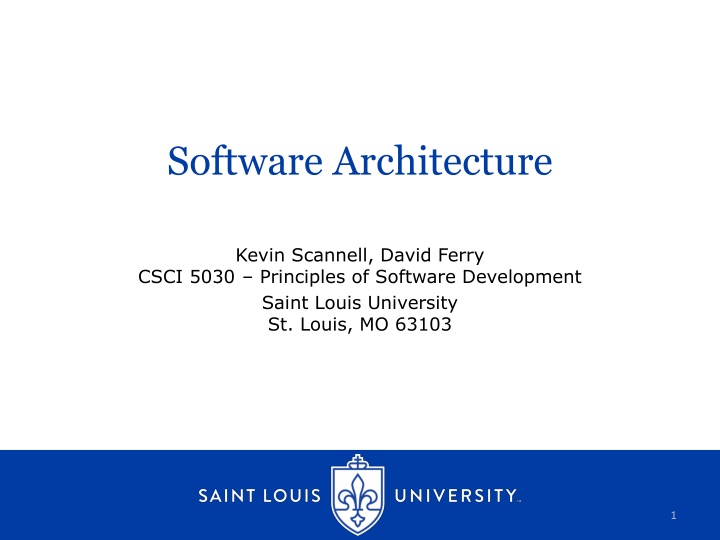
Software Architecture: Challenges and Solutions
Dive into the world of software architecture as we explore the problems architects solve, tools they use, constraints they consider, and the importance of performance, scalability, and other attributes in modern systems.
Download Presentation

Please find below an Image/Link to download the presentation.
The content on the website is provided AS IS for your information and personal use only. It may not be sold, licensed, or shared on other websites without obtaining consent from the author. If you encounter any issues during the download, it is possible that the publisher has removed the file from their server.
You are allowed to download the files provided on this website for personal or commercial use, subject to the condition that they are used lawfully. All files are the property of their respective owners.
The content on the website is provided AS IS for your information and personal use only. It may not be sold, licensed, or shared on other websites without obtaining consent from the author.
E N D
Presentation Transcript
Software Architecture Kevin Scannell, David Ferry CSCI 5030 Principles of Software Development Saint Louis University St. Louis, MO 63103 1
https://xkcd.com/2030/ CSCI 5030 Principles of Software Development 2
What is Software Architecture? Still an infant discipline Little understood by practitioners, teachers, and especially students Some basic questions are not answered: What problems does an architect solve? What are the tools that are used? What are the constraints that are considered? Is there an underlying consistent theory? And yet you know it when you see it Lots of individual approaches and silos of knowledge, no unified theory CSCI 5030 Principles of Software Development 3
What Problems Does an Architect Solve? How do customer requirements map into technology needs? How is a high-level task divided into low-level software units? How are software components connected? How do software components map to hardware components? How are business objectives met and how do stakeholders interact with the software? How are non-functional attributes achieved? CSCI 5030 Principles of Software Development 4
What tools are used? Stakeholder interaction: user stories, requirements, specifications, etc Modeling: system-level modeling and physical simulation, formal verification, model checking, Documentation: block or component diagrams, UML diagrams, ER models, call graphs, etc Architecture patterns: describe how software components interact with each other Software design patterns: describe how individual components might be implemented CSCI 5030 Principles of Software Development 5
What constraints are considered? Performance and scalability, both now and in the future This is where many large tech companies have their edge Facebook, Twitter, etc. are not conceptually difficult to implement Other attributes: adaptability, testability, maintainability, availability, reliability, recoverability, safety, and security Cost to build and maintain system CSCI 5030 Principles of Software Development 6
Is there a consistent theory? Any architecture can be considered an abstraction or model of an actual system. Each abstraction specifies a certain structure that yields a desired attribute. Each abstraction has some set of prerequisite assumptions that motivate the specific structure. The basic goal of a practicing software architect is to identify the existing abstractions relevant to a new work in order to simplify the design and implementation process. Alternately, the absence of relevant abstractions hints at the opportunity to add to the universe of discourse. CSCI 5030 Principles of Software Development 7
Software Architecture Examples Client/Server Model A central Server provides services to multiple callers called Clients Examples: internet in general Master/Slave Model A central Master sends requests to multiple workers called Slaves Inverse of Client/Server Voted most politically-incorrect term of 2004 Examples: Bluetooth CSCI 5030 Principles of Software Development 8
Software Architectural Examples Service-Oriented Architecture All services are provided through a network communication protocol Any component can access and request services from any other component Components work together regardless of language, technology, physical location, etc. Easy to compose higher level services from lower level services Individual components are separately maintained and deployed Example: Amazon in its entirety CSCI 5030 Principles of Software Development 9
Software Design Pattern Examples Active Object Introduces concurrency natively through asynchronous object methods Traditional Object Active Object Object.methodA(); Object.methodA(); Object Object Thread Pool Object.getResult() methodA() methodA() Result Result CSCI 5030 Principles of Software Development 10
Software Design Pattern Examples Factory Pattern How do we create objects if we don t know the type beforehand? Not maintainable (what if taxi2 has a different engine?): var motor; if ( type == gasoline ) motor = new gasEngine(); elseif ( type == electric ) motor = new electricEngine(); taxi = new Car( motor ); CSCI 5030 Principles of Software Development 11
Software Design Pattern Examples Factory Pattern: create any abstract type in one method class EngineFactory() GetEngine( type ){ if ( type == gasoline ) return new gasEngine(); elseif ( type == electric ) return new electricEngine(); } var motor = EngineFactory.getEngine( type ); taxi = new Car( motor ); CSCI 5030 Principles of Software Development 12
What next? You could spend multiple semesters looking at a veritable zoo of architectural artifacts. Software architecture is more than just having a catalogue of existing patterns It s analyzing and understanding the key challenges in a software project It s seeing how existing abstractions do and don t solve those challenges Our approach: case studies- Mozilla and Twitter CSCI 5030 Principles of Software Development 13
